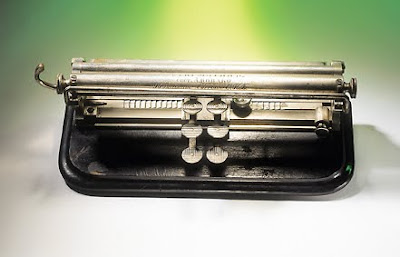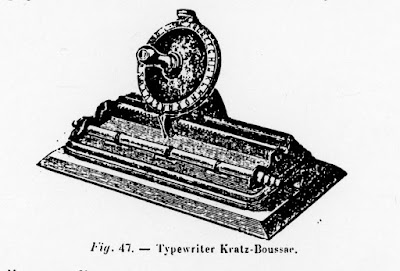What is a Marilla? All I knew until today was this partial photo of a dirty machine, with a QWERTZ keyboard and a shift key reading "Dole [?] Litery."

Then I decided to check the Typewriter Lexicon in the members' area of IFHB. Bingo! Thomas Fürtig added this machine to his vast collection, and it is a name variant of the Senta 1. (Serious collectors should join this organization. Its predominant language is German, but yours truly translates the monthly newsletter into English, and the website is bilingual.)

Eccentric typewriter inventors dream up new keyboard arrangements. Hard-core eccentrics go farther and change the shape of the keys. Claude Marsan was one of those idealists. His life project was to develop a new kind of keyboard for the French language, and a few Marsanized typewriters exist. Here we see a Hermes standard and what I believe is a Facit portable.


Marx is a familiar name in toy typewriters, but have you seen a Marx "Valentine" before?

The Maskelyne Victoria is a thing of great beauty and mystery. This one (the only one?) belongs to London's Science Museum. Story in ETCetera No. 100.

Another British invention is this Matrix Model G Braille writer (#237).

This Mima is a cute little Italian plaything.

Our next Italian machine is much more impressive. It's not obscure to informed collectors, but it's the only one known, and it is such a work of art that I have to include it here: the Minerva, from the collection of the MTE museum in Catalonia.

Back to basics: the Minitype.

Another peculiar Italian machine is the Montana Media, also known as the model 102/A. Montana is generally known for producing clones of the Hermes Baby, but this is a very different design that's either a very good children's typewriter or a very lightweight serious typewriter.

What's this? I have it as "Morse typewriter?" but it really belongs in my Mystery folder.

The following object caused a stir among collectors in 2004. The Ingersoll, one of the simplest and most ridiculous "typewriters" ever, was reportedly also marketed as the Nason. This "Nason" turned up on eBay, excited suspicion, and disappeared. Many collectors believed that it was a fake, built in order to turn a buck. But who knows?


Here's another one of these keyboard devices that aren't strictly typewriters but that fascinate me: The National Telegraph Transmitter, #113.




This monstrous 1960s (?) NCR typewriter/bookkeeping machine may be a descendant of the Ellis.


This New Sholes shows that the Sholes family kept trying to produce successful typewriters—without success. I don't recall which Mr. Sholes created this one.

The Nototyp, also known as the Notoscript, is among the more obscure music typewriters.


Here's a more modern machine, complete with its '90s teal plastic: the Ntouch D.I.T. (Digital Inkjet Typewriter), marketed for "Children 6 and over." This was actually a pretty innovative way for a keyboard device to get ink onto paper. It's an interesting hybrid of printer and typewriter technology.


This imposing Japanese typewriter is an Ohtani from 1928 (#5199).


Finally, the Osma was a very shortlived postwar German portable. This specimen from the collection of the late Tilman Elster is now in my own collection.


Then I decided to check the Typewriter Lexicon in the members' area of IFHB. Bingo! Thomas Fürtig added this machine to his vast collection, and it is a name variant of the Senta 1. (Serious collectors should join this organization. Its predominant language is German, but yours truly translates the monthly newsletter into English, and the website is bilingual.)

Eccentric typewriter inventors dream up new keyboard arrangements. Hard-core eccentrics go farther and change the shape of the keys. Claude Marsan was one of those idealists. His life project was to develop a new kind of keyboard for the French language, and a few Marsanized typewriters exist. Here we see a Hermes standard and what I believe is a Facit portable.


Marx is a familiar name in toy typewriters, but have you seen a Marx "Valentine" before?

The Maskelyne Victoria is a thing of great beauty and mystery. This one (the only one?) belongs to London's Science Museum. Story in ETCetera No. 100.

Another British invention is this Matrix Model G Braille writer (#237).
This Mima is a cute little Italian plaything.

Our next Italian machine is much more impressive. It's not obscure to informed collectors, but it's the only one known, and it is such a work of art that I have to include it here: the Minerva, from the collection of the MTE museum in Catalonia.

Back to basics: the Minitype.

Another peculiar Italian machine is the Montana Media, also known as the model 102/A. Montana is generally known for producing clones of the Hermes Baby, but this is a very different design that's either a very good children's typewriter or a very lightweight serious typewriter.
What's this? I have it as "Morse typewriter?" but it really belongs in my Mystery folder.

The following object caused a stir among collectors in 2004. The Ingersoll, one of the simplest and most ridiculous "typewriters" ever, was reportedly also marketed as the Nason. This "Nason" turned up on eBay, excited suspicion, and disappeared. Many collectors believed that it was a fake, built in order to turn a buck. But who knows?


Here's another one of these keyboard devices that aren't strictly typewriters but that fascinate me: The National Telegraph Transmitter, #113.




This monstrous 1960s (?) NCR typewriter/bookkeeping machine may be a descendant of the Ellis.


This New Sholes shows that the Sholes family kept trying to produce successful typewriters—without success. I don't recall which Mr. Sholes created this one.

The Nototyp, also known as the Notoscript, is among the more obscure music typewriters.


Here's a more modern machine, complete with its '90s teal plastic: the Ntouch D.I.T. (Digital Inkjet Typewriter), marketed for "Children 6 and over." This was actually a pretty innovative way for a keyboard device to get ink onto paper. It's an interesting hybrid of printer and typewriter technology.

This imposing Japanese typewriter is an Ohtani from 1928 (#5199).
Finally, the Osma was a very shortlived postwar German portable. This specimen from the collection of the late Tilman Elster is now in my own collection.


















